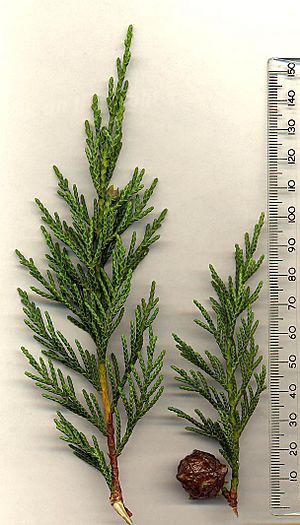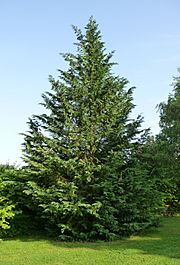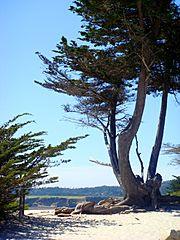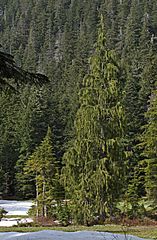Leyland cypress facts for kids
Quick facts for kids Leyland cypress |
|
|---|---|
 |
|
| Leyland cypress foliage and cone | |
| Scientific classification | |
| Kingdom: | |
| Division: | |
| Class: | |
| Order: | |
| Family: | |
| Genus: | |
| Species: |
C. × leylandii
|
| Binomial name | |
| Cupressus × leylandii A. B. Jacks. & Dallim.
|
|
| Synonyms | |
|
|
The Leyland cypress, known scientifically as Cupressus × leylandii, is often simply called leylandii. It is a very fast-growing coniferous evergreen tree. People often use it in horticulture to create tall hedges and privacy screens. These trees can grow very quickly. Some have reached 15 metres (49 ft) (about 50 feet) in just 16 years, even in poor soil. Because they grow so fast and thick, they are great for privacy. However, this rapid growth can sometimes cause problems with neighbors if the trees block their sunlight.
The Leyland cypress is a hybrid tree. This means it is a mix of two different parent trees. Its parents are the Monterey cypress (Cupressus macrocarpa) and the Nootka cypress (Cupressus nootkatensis). Most Leyland cypresses cannot produce seeds. Because of this, new trees are usually grown from cuttings taken from existing plants.
Contents
How the Leyland Cypress Was Created
The story of the Leyland cypress began in 1845. A banker named Christopher Leyland bought a large estate called Leighton Hall, Powys. In 1847, he gave the estate to his nephew, John Naylor. John Naylor hired a landscape architect, Edward Kemp, to design the gardens.
These gardens included many interesting trees. Among them were two types of North American conifers planted close together. These were the Monterey cypress and the Nootka cypress. In nature, these two trees usually do not grow near each other. Their natural homes are over 400 miles (640 km) apart. But in 1888, something special happened at Leighton Hall. The female flowers (or cones) of a Nootka cypress were pollinated by pollen from a Monterey cypress. This created the first Leyland cypress hybrid.
Developing New Varieties
John Naylor's oldest son, Christopher John, took over Leighton Hall in 1889. Christopher was a sea captain. In 1891, he inherited more land and moved to Haggerston Castle in Northumberland. He continued to grow and study the new hybrid trees there. He named the first type of Leyland cypress 'Haggerston Grey'.
His younger brother, John, inherited Leighton Hall. In 1911, the opposite cross happened. This time, the cones of a Monterey cypress were pollinated by pollen from a Nootka cypress. This new hybrid was named 'Leighton Green'.
Since then, the Leyland cypress hybrid has appeared almost 20 times naturally. This shows that the two parent species are very compatible. Even though most Leyland cypresses are sterile, new trees are grown from cuttings. This means almost all the Leyland cypresses you see today came from those first few hybrid plants.
There are over 40 known types, or forms, of Leyland cypress. Besides 'Haggerston Grey' and 'Leighton Green', other famous forms exist. 'Stapehill' was found in 1940 in a garden in Dorset, England. 'Castlewellan' came from a special tree in the Castlewellan estate in Northern Ireland. This type became very popular in the 1970s.
What Leyland Cypress Looks Like
The Leyland cypress is a large evergreen tree. It can grow between 20 and 25 meters (about 65 to 82 feet) tall. Its leaves are very dense, making the tree look full and compact. It grows very quickly, adding about 1 meter (3 feet) in height each year.
The leaves are small, about 1 millimeter long. They grow close to the twigs and have a slightly fresh smell. They are usually dark green, but can be lighter on the underside. Different types of Leyland cypress can have different leaf colors. The top part of many Leyland cypresses is shaped like a wide column. Its branches are a bit flat and covered with many small, scale-like needles. The tree's bark is dark red or brown and has deep grooves.
The seeds of the Leyland cypress are found inside small cones. These cones are about 2 centimeters (less than an inch) long. Each cone has eight scales and five seeds. The seeds have tiny resinous vesicles. Since the Leyland cypress is a hybrid, its seeds are usually sterile. This means they cannot grow into new trees. Over time, the cones dry out and shrink. They turn gray or chocolate brown and become about 1 centimeter (less than half an inch) wide.
Parent Trees of Leyland Cypress
The Leyland cypress is a hybrid of two other cypress trees: the Monterey cypress (Cupressus macrocarpa) and the Nootka cypress (Cupressus nootkatensis). Scientists have changed how they classify the Nootka cypress over the years. This has made the scientific name of the Leyland cypress a bit complicated.
Originally, the Nootka cypress was placed in the Cupressus group. Later, it was moved to the Chamaecyparis group. More recently, some scientists have suggested putting it in a new group called Callitropsis.
The scientific name of the Leyland cypress depends on how scientists classify the Nootka cypress.
- If Nootka cypress is called Cupressus nootkatensis, then the hybrid is Cupressus × leylandii.
- If both parent trees are in the Callitropsis group, the hybrid is Callitropsis × leylandii.
- If the parents are considered to be in different groups, the hybrid gets a name like ×Cupressocyparis leylandii or ×Cuprocyparis leylandii.
Two other similar hybrid trees have also been created. They both involve the Nootka cypress mixed with other Cupressus species:
- Cupressus arizonica var. glabra × Cupressus nootkatensis (called Cupressus × notabilis)
- Cupressus lusitanica × Cupressus nootkatensis (called Cupressus × ovensii)
Where Leyland Cypress Grows Best
Leyland cypress trees need a lot of sunlight to grow well. They can handle a lot of air pollution and even salty air, which is good for coastal areas. They are strong, fast-growing natural hybrids. They can grow in many different types of soil. People often plant them in gardens to quickly create a boundary or a hedge for privacy. Even though they are widely used for screens, they are not often planted for large forests.
The Leyland cypress combines the toughness of the Nootka cypress with the fast growth of the Monterey cypress. The tallest Leyland cypress recorded is about 40 m (130 ft) (about 130 feet) tall and is still growing.
Challenges for Leyland Cypress
However, Leyland cypresses have shallow roots. This means that very large trees can sometimes fall over, especially in strong winds. Their shallow roots also make them struggle in places with very hot summers, like the southern United States. In these areas, they can get a disease called cypress canker. This disease is caused by a fungus called Seiridium cardinale. Canker causes parts of the tree to die back and can eventually kill the whole tree. In places like California's Central Valley, they often don't live more than 10 years because of this disease. The Arizona cypress is a better choice in these areas because it resists canker.
In northern areas with heavy snow, Leyland cypresses can also have problems. Wet, heavy snow can break their branches or even uproot the whole tree. The tree has also been introduced in Kenya, on parts of Mount Kenya. The sap from the Leyland cypress can sometimes cause skin irritation for people who are sensitive to it.
How Leyland Cypress Became Popular
In 1925, a company that specialized in growing conifers was looking for a fast-growing tree. They wanted a tree that could grow well in tough, windy, and salty places like Cornwall, England. They found the six original Leyland cypress trees that Christopher Leyland had developed. They started growing and selling these trees.
In 1953, a strong tornado blew down one of the original trees at Haggerston. The other five original trees are still alive today. The research part of the Forestry Commission then started to develop even more types of Leyland cypress. Tree nurseries quickly saw how popular this plant could become. For many years, the Leyland cypress was the best-selling item in garden centers across Great Britain. It made up to 10% of their total sales!
Uses of Leyland Cypress
Leyland cypress trees are still very popular for planting in parks and gardens. People commonly plant them to quickly create fences or tall privacy hedges. However, their very fast growth (up to 1 meter per year) and their thick shade can cause issues. They can also grow very large, often over 20 meters (65 feet) tall in gardens, and can reach at least 35 meters (115 feet). This large size can sometimes be a problem for smaller gardens.
Different Types of Leyland Cypress
A cultivar is a plant type that has been chosen and grown by people for certain features. The Leyland cypress cultivar called 'Gold Rider' has won an important award, the Royal Horticultural Society's Award of Garden Merit. However, the original Leyland cypress hybrid itself has lost its award status.
Other popular types of Leyland cypress include:
- 'Douglas Gold'
- 'Leighton Green'
- 'Drabb'
- 'Haggerston Grey'
- 'Emerald Isle'
- 'Ferndown'
- 'Golconda'
- 'Golden Sun'
- 'Green Spire'
- 'Grelive'
- 'Harlequin'
- 'Herculea'
- 'Hyde Hall'
- 'Irish Mint'
- 'Jubilee'
- 'Medownia'
- 'Michellii'
- 'Moncal'
- 'Naylor's Blue'
- 'New Ornament'
- 'Olive's Green'
- 'Robinson's Gold'
- 'Rostrevor'
- 'Silver Dust'
- 'Variegata'
- 'Ventose'
- 'Winter Sun'
Famous Leyland Cypress Trees
At the U.S. Space & Rocket Center in Huntsville, Alabama, there are twenty Leyland cypresses. They line a raised area in their Rocket Park.
Gallery
-
A 'Naylor's Blue' Leyland cypress in a botanical garden in Wrocław.
See also
 In Spanish: Ciprés híbrido de Leyland para niños
In Spanish: Ciprés híbrido de Leyland para niños













